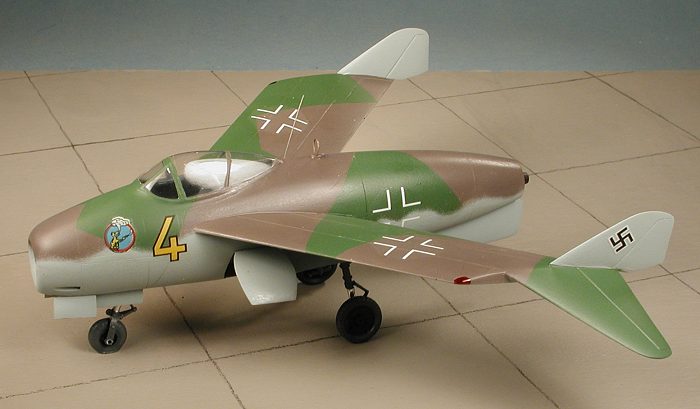
Just Fantasy 1/48 BV P.212.3
|
KIT # |
4801 |
|
PRICE: |
$ |
|
DECALS: |
one aircraft |
|
REVIEW : |
|
|
NOTES: |
Resin with vac canopy and decals |

|
CONSTRUCTION |
Since the Bv 212.3 is a resin kit, the first thing you really want to do is to wash the parts. Now I donít usually do this on airplane kits as I generally end up sanding most of it before paint ever hits it, but it is the normal procedure for these kits.
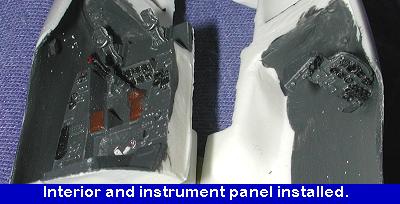 First assembly process is on
the interior. This is superbly molded and quite reminiscent of a ProModeler
Me-410 interior, especially in the webbing of the seat. Where it comes from
isnít important, but it does look great. You get separate rudder pedals and
control stick as well. These were all glued together. Then the cockpit and the
interior of the fuselage halves were painted RLM 66 dark grey. This time I used
Model Master enamels to ensure good stick.
First assembly process is on
the interior. This is superbly molded and quite reminiscent of a ProModeler
Me-410 interior, especially in the webbing of the seat. Where it comes from
isnít important, but it does look great. You get separate rudder pedals and
control stick as well. These were all glued together. Then the cockpit and the
interior of the fuselage halves were painted RLM 66 dark grey. This time I used
Model Master enamels to ensure good stick.
While this was drying, the instrument panel was painted flat black and drybrushed to bring out detail. Then it was glued into one fuselage half. This instrument panel doesnít fit quite as nicely as Iíd have hoped, but there are little placement tabs on the interior that really help. The cockpit was then detailed with various colors and drybrushed with aluminum. With the interior and cockpit dry, the cockpit was glued in place. Fit here is quite good. Unfortunately for me, I got mine in a bit crooked and it lists a bit to one side. An additional alignment strip in the other fuselage half would be a big help (hint, hint).
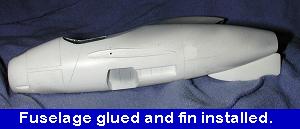 With the cockpit glued in
place the fuselage halves were glued together. Since the mating surfaces had
been sanded relatively smooth, fit was quite good. I used superglue for this
process. When dry, the seams were treated to another dose of superglue which was
hit with accelerator and quickly sanded smooth. I must warn you that the resin
used on this kit is a bit softer than some. This makes it easier to sand, but
also makes it more susceptible to over-sanding, so take heed.
With the cockpit glued in
place the fuselage halves were glued together. Since the mating surfaces had
been sanded relatively smooth, fit was quite good. I used superglue for this
process. When dry, the seams were treated to another dose of superglue which was
hit with accelerator and quickly sanded smooth. I must warn you that the resin
used on this kit is a bit softer than some. This makes it easier to sand, but
also makes it more susceptible to over-sanding, so take heed.
At about the same time, the wings were prepared. This aircraft does not have conventional tail surfaces. Instead, they are on the wing tips. The tips themselves are separate and have a substantial amount of droop. At the wing tip/wing join, there is a small fin with rudder that fits there. To add to the interest, the wings themselves have an upward slant, so getting things aligned is quite a feat.
What I did was to first glue on the downward slanting wing tips. The mating surface is also the resin block attachment point so youíll have to use your sanding skills to get this surface pretty close. I glued both wing tips at about the same time. This was to get the same angles for both. When dry, I noticed that there were gaps on both the top and bottom that needed attention. These were too large for superglue and would have taken several coats of normal putty. What I used was A+B epoxy putty. It was smoothed as much as possible while it was still soft. When it dried, all that was needed was some minor attention with several grades of sandpaper to smooth things out.
While this was going on, the fuselage was sprayed with primer (after filling the cockpit with tissue, of course). This showed several areas that needed filler. I used both regular filler and super glue to patch these areas. Probably the most difficult to work on was the intake. This took several applications and I had to use rolled sandpaper to smooth it out. Not perfect, but acceptable. Another coat or two of primer to make sure that all the glitches were fixed and the panel lines that were filled were rescribed.
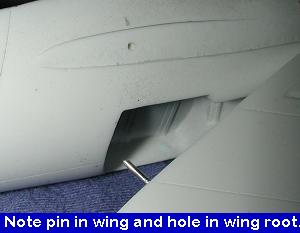 The kit also comes with a
fuselage strake that is supposed to fit on the top of the fuselage. I have seen
drawings of this plane without it so it is your call on using it. I decided to
add it to my model, but placed it on the bottom of the fuselage instead of the
top. It just looks better in that location.
The kit also comes with a
fuselage strake that is supposed to fit on the top of the fuselage. I have seen
drawings of this plane without it so it is your call on using it. I decided to
add it to my model, but placed it on the bottom of the fuselage instead of the
top. It just looks better in that location.
With the wings and fuselage relatively complete, it was time to mate the two. There is no positive alignment with these, just a butt join. That isnít good enough for me so I drilled holes in the wing to accept a section of paper clip. Then I lined it up with the fuselage and, after making a mark as to where it should be, drilled a hole in the fuselage to accept the pin. I used a #64 drill bit for these holes as it is about the same diameter as your standard paper clip. The join area was coated with superglue and the wing glued on. Only a minor amount of fiddling was needed to get them aligned properly.
 Attention then turned to the
wing fins. These were glued in place and when dry, these areas were given a coat
of primer to see how much filler was needed. Actually, not as much as first
feared. A few coats on some places took care of it. Again, I used both regular
filler and superglue for these areas.
Attention then turned to the
wing fins. These were glued in place and when dry, these areas were given a coat
of primer to see how much filler was needed. Actually, not as much as first
feared. A few coats on some places took care of it. Again, I used both regular
filler and superglue for these areas.
During all these operations, I worked on the other bits to the kit, the
landing gear. The doors are commendably thin and after easy removal from the
resin blocks, were given primer coats on both sides and set aside until
painting. The landing gear themselves needed to have the seams cleaned up and
the holes in the oleo scissors were drilled out as well. When cleaned up as best
as possible, they were given a coat of RLM 66 and set aside to dry. Now some of
you may be wondering why I didnít use RLM 02. I could have, and could also have
used black. All three colors were used on landing gear by the late war years and
it seemed reasonable that all three would have continued in use. When dry, the
oleos themselves were wrapped in Bare Metal Foil bright chrome. Wheels were
painted black with 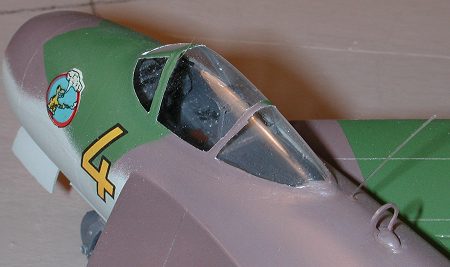 dark grey tires and set aside. In order to make sure that
they'd fit well in the wheel wells, I drilled out the top of each strut as much
as I could and inserted a section of paper clip. In the wheel wells, the strut
locations were marked and also drilled out. Test fitting the struts showed that
they actually fit!
dark grey tires and set aside. In order to make sure that
they'd fit well in the wheel wells, I drilled out the top of each strut as much
as I could and inserted a section of paper clip. In the wheel wells, the strut
locations were marked and also drilled out. Test fitting the struts showed that
they actually fit!
Back at the airframe, only a few more preparatory steps were needed prior to overall painting. One was to attach the ADF loop antenna mount and the other was to attach the gunsight, head armor, and the canopy. Pend Oreille gives you two crystal clear canopies for the kit. I decided to do mine with the canopy closed as you can see everything on the inside and it would look sleeker. As usual, vac canopies of any kind are not a favourite of mine, however, I did get it glued in place with non-fogging superglue. There were many gaps. These were filled with multiple applications of filler and sanded smooth. Then the canopy was masked in preparation for painting and it was off to the paint shop.
|
PAINT & DECALS |
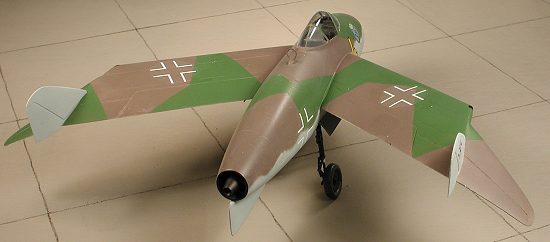 I decided to be pretty normal about this kit and so began by
painting the underside RLM 76 light blue using Aeromaster enamel. The gear doors
got the same treatment on the outside. Then the uppersurface was sprayed with
RLM 83 bright green and when dry, masked off in a splinter pattern and sprayed
with RLM 81 brown-violet, a rather typical 1945 camouflage scheme. The usual
back and forth spraying went on and then it was sprayed with clear gloss acrylic
when the underlying Aeromaster enamels had fully cured.
I decided to be pretty normal about this kit and so began by
painting the underside RLM 76 light blue using Aeromaster enamel. The gear doors
got the same treatment on the outside. Then the uppersurface was sprayed with
RLM 83 bright green and when dry, masked off in a splinter pattern and sprayed
with RLM 81 brown-violet, a rather typical 1945 camouflage scheme. The usual
back and forth spraying went on and then it was sprayed with clear gloss acrylic
when the underlying Aeromaster enamels had fully cured.
Just
Fantasy includes a set of decals that are the same as in the Pend Oreille 1/35
Bf-109G-6. They are nicely done and include basic insignia, a swastika, and a
blue number 2. Like the 109 sheet, it is apparently done on an Alps printer.
Also like the 109 sheet, the decals are totally impervious to any setting
solutions and will not snuggle down into panel lines. I used the kit supplied
decals on the underside and went to the spares bin for all the others. I found
the yellow 4 in an old Monogram 1/48 Fw-190 sheet and the unit insignia from an
equally ancient Hasegawa 1/72 RA-5C sheet. They all worked just fine and
succumbed to Solvaset with no problems at all.
|
FINAL BITS |
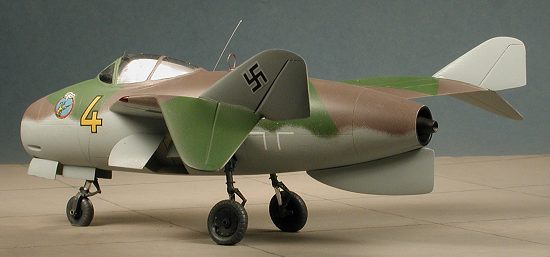 At this time,
the landing gear were glued into place and at what I hope were the proper angle!
I had to do some drilling and sanding on the wheels at wheel attachment points
to get them to fit well. The gear doors were just butt fit in place and seem to
hold up well. The small resin loop antenna was sanded off the resin leaf it was
on and glued in place. A small hole was drilled aft of the canopy to accept the
small whip antenna that was going to go there. Any paint touch-up was done at
this time and the entire kit sprayed with a matte clear to seal in the decals.
Then the exhaust cone was glued in place and the wing tip lights were painted
with Gunze clear red and green. The last step was to remove the masking from the
canopy and to install a short piece of clear stretched sprue for the whip
antenna and I was done!
At this time,
the landing gear were glued into place and at what I hope were the proper angle!
I had to do some drilling and sanding on the wheels at wheel attachment points
to get them to fit well. The gear doors were just butt fit in place and seem to
hold up well. The small resin loop antenna was sanded off the resin leaf it was
on and glued in place. A small hole was drilled aft of the canopy to accept the
small whip antenna that was going to go there. Any paint touch-up was done at
this time and the entire kit sprayed with a matte clear to seal in the decals.
Then the exhaust cone was glued in place and the wing tip lights were painted
with Gunze clear red and green. The last step was to remove the masking from the
canopy and to install a short piece of clear stretched sprue for the whip
antenna and I was done!
|
CONCLUSIONS |
As resin kits go, this one is at the top of my easy and fun to do list. It would make a very good kit for someone who is ready to start doing resin aircraft kits as it has minimal cleanup hassles and yet gives all the required opportunity to use skills that are needed for the genre. I really liked this kit and look forward to seeing what is next in the series.
August 2001
June 2007 - Very late entry. The resin nose gear was unable to handle the weight and collapsed after about a year. I recommend running a piece of metal rod up through the tire into the nose strut so that it will stay straight. I also believe that Pend Oreille is now out of business as I've seen nothing new from them for a very, very long time.

Copyright ModelingMadness.com. All rights reserved.
If you would like your product reviewed fairly and fairly quickly, please contact the editor or see other details in the Note to Contributors.